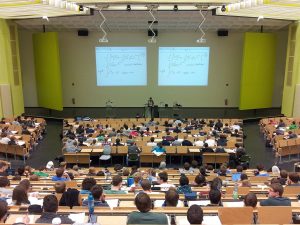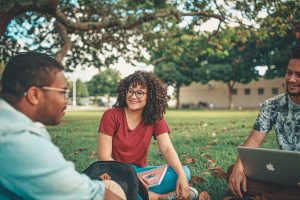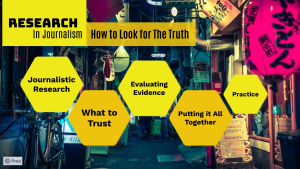39 Research in Journalism
Learning Objectives
-
Explore concepts about academic research, specifically in Journalism.
-
Analyze two opposing points of view and decide which is the stronger argument; cite textual evidence.
Chapter & Discussion
This chapter includes a presentation that can be navigated in a classroom setting or independently. You can access the presentation via the link below.
Research in Journalism: How to Look for the Truth
Work through the different sections of the chapter and discuss ideas and topics as they arise. If you’re working independently, take notes instead. Notes and active discussion will be helpful in navigating this week’s assignments.
Journalistic Research
Journalists use a variety of methods to conduct research and find facts for their stories, including:
Interviewing sources – This could include eyewitnesses, experts, officials, etc. Effective interviewing requires preparing good questions ahead of time and listening closely to responses.
Library/online research – Searching through books, academic journals, magazines, newspaper archives, and reliable websites to find historical context, precedent, quotes, etc.
Fact-checking – Verifying key details, claims, names, numbers, etc. cited by sources through further documentation and confirmation.
Documentary Research – This may include government documents, legal filings, academic studies, and other sources that provide factual data.
In College and the Workforce
In college and the workforce, you will often be asked to defend your ideas. To do this, you’ll need to build a case for them with arguments and evidence.
The evidence you provide should come from research.
There is a lot of information available (especially digitally) and it can be difficult to determine:
- Which sources you trust
- How to tell good evidence from bad evidence
- And the purpose and audience of a source

What to Trust
It can be difficult to determine whether or not a source is credible or trustworthy. When researching, there are a few strategies that can help.
- Lateral Reading (developed by John Green in Crash Course: Navigating Digital Information) is the act of checking sources for credibility as you read them. You can use newspaper articles and fact-checking sites like Politifact and Snopes for this.
- Try to determine the authority of an author by finding out their professional background, the process they used to produce the information, and whether they have systems in place to catch mistakes.
- Try to determine the perspective of an author: consider their reason for sharing the information and how their views might influence their writing.
Evaluating Evidence
When researching, you will need to evaluate the evidence that sources provide to defend their claims. Here are a few questions to ask yourself:
- Does the author cite credible sources?
Check the citations and make sure they come from trusted institutions. - Is there context for the evidence they provide and is it relevant to their case?
The author should provide context in the form of similar evidence from other, unbiased sources. It should also feel relevant to the issue at hand. - How easy would it be to fact check?
Credible sources are easy to fact check. If you can’t find anything to back it up, it might not be trustworthy.

Putting it All Together
As journalists research, they are consulting mutliple sources (as many as they can find) and trying to put together a picture that makes sense.
If two sources don’t add up, they have to try to fact check each to figure out who (or what) is telling the truth.
If a source didn’t tell the truth, part of their job is to report on that, and provide evidence to the audience to show them what is true.
Journalists constantly practice critical thinking, ethical decision-making, and digital literacy to make sure they report the truth.
Assigned Reading
Here are this week’s readings. Additionally, please read for your own personal enjoyment for 1/2 hour each day. This will be called your “Reading Zone” reading and it will coincide with many upcoming activities.
Deciding Who to Trust by John Green (via Crash Course)
Problem Set: Practice Your Skills!
Click here to complete a ten-question problem set on concepts in this chapter.
Completing problem sets like this can be an important element of independent study towards completing your HSE. I write these to resemble the style of questions you’ll find on the Reading and Language Arts GED.
Assignment: Fact Checking an Editorial (250 Words)
Start by watching Crash Course: Deciding Who to Trust by John Green.
Find an opinion article that you think you might disagree with (you can search google news for “opinion” to do this). As you read, take one page of notes in the form of a bulleted list. Your notes should include the following:
-
Do some lateral reading on the author and note whether or not you think they are trustworthy.
-
Try to fact check something in the article. You might try a fact checking site like Snopes.
-
Discuss any bias you find in the article.
-
In your notes, include something about how you would respond to this editorial.
Assignment: Reading Zone Response (250 Words)
For Reading Zone, you must find a novel that is interesting to you and enjoyable to read. If you need help finding a Reading Zone book, please ask. Please read your Reading Zone book for a half-hour each day. On class days, there will be time in class dedicated to reading.
Create a two-paragraph response to the reading you did this week. The first paragraph should summarize what you read this week. The second paragraph should address the following prompt:
Compare this book with another book that has a shared goal. What was the goal and who did it better? Explain your answer.
Attribution
Green, J (2019). Check Yourself with Lateral Reading: Crash Course Navigating Digital Information #3. Crash Course.


